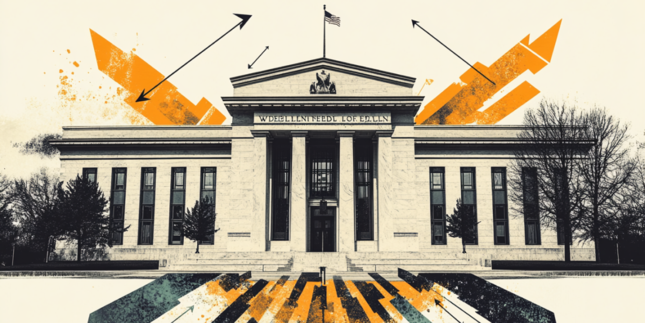Andrew Pancholi is one of the world’s leading experts on market cycles and the author of the highly acclaimed Market Timing Report. In addition, Andrew is a consultant for institutional investors, hedge funds and major banks. He is a board member for The Foundation For Study Of Cycles (FSC), which was set up by the US Presidency in the 1940’s. The FSC is dedicated to the study of recurring patterns in the economy, natural and social sciences, as well as the arts.
Can you tell us about how you initially became interested in the world of cycles?
As a student of economics I was introduced when the Kondratiev wave and the concept of 60 year cycles was brought up. I went on to discover other cycles and noticed that events were recurring at regular intervals. I looked at things like World War I taking place between 1914-1918 and going back 100 years and seeing the Battle of Waterloo (1815).
Many religious and philosophical texts allude to repetition in cycles, you can see it in both Hinduism and Christianity. A clear example is in the Bible, Ecclesiastes 1:9: “The thing that hath been, it is that which shall be; and that which is done is that which shall be done: and there is no new thing under the sun.”
As you look at every culture you can see that everybody follows cycles, either openly or discretely. People are not necessarily aware of them, but we have a birthday every year and of course we also have the four seasons of the year; the planting season of spring, growing season of summer, autumn harvest and then winter where everything resets for the next rotation.
When we look at markets we see similar patterns unfold in Elliott Wave, where we get the five waves up and three waves down and this really piqued my interest. Many people are familiar with the decennial cycle that was first written about in 1939 by Edgar Lawrence Smith, in his book Tides in the Affairs of Men. He basically identified that typically years ending in 5 were very bullish, years ending in 7 tended to have pullbacks, years ending in 0 and 1 tended to be bearish and that’s pretty much what we’ve been seeing.
Just as we look at the cycles from the 10 year cycle, we find that there’s a 100 year cycle – this is a fractal pattern of the 10 year cycle. 100 years on from the 1907 Rich Man’s Panic we saw the Global Financial Crisis of 2007/2008. If you were to go back to 1907 and back another 100 years, we can see the Embargo Act of 1807, which precipitated a huge crash. So basically we can see that these cycles are there and that’s really how I got into it – seeing that there is a degree of predictive capability, which is quite obvious, but few people choose to see or recognize it.
Can you describe the proprietary cycles analysis software that is used to generate the Market Timing Report?
As I continued the research of longer term cycles, it seemed obvious that there were some other smaller cycles at play. The more I looked into this, the more confusing it became so I stripped them down into different layers. The idea is that if you have a long term cycle and it coincides with a medium term cycle and also a short term or a daily cycle, then where all those three align is where we get big events coming together. So we programmed all these short term and medium term cycles in, gave them a weighting and created histograms. These histograms are predictive. We can anticipate some of the monthly and weekly cycles several years into the future. This can be up to 10 years for some of the monthly cycles and certainly five years for the weekly cycles. This gives us an idea of where a market is likely to change trend, they are like momentum points or energy points. That was the purpose of developing the software because these calculations were far too complex to carry out by hand.
What role does seasonality and Commitments of Traders data play when combined with cycles analysis?
What we found was that we can generate tipping points in markets and 90% of the time we’d see a reversal. For me it was fairly obvious that as the market unfolded into the forthcoming time point there would be a reversal of trend. However, every now and then we saw an acceleration so we thought about how else we can get the odds on our side. What else can give us clues? Seasonality is a fairly obvious one. Most people will have heard sayings like sell in May and go away for the stock market or the Santa Claus rally. Equally, gold has a very strong seasonal profile. In September it is generally very bullish. The more we look across different commodities, especially things that grow out of the ground we can see that they have very clear patterns because they are directly related to the seasonal growing patterns. Using seasonality helps us get the odds on our side. Then, with the Commitment of Traders (CoT) data we can see what the smart money is doing and what the dumb money is doing. CoT data can often get to extremes, but we can be at those extremes for several weeks or even months. We know that the market is about to turn up or turn down, but we’re not sure when. The window can often be several weeks. This is where our histograms are incredibly powerful and very important because they can help accurately time things, certainly down to a week and often down to a day.
You studied extensively the work of WD Gann, Edward Dewey and Ralph Nelson Elliott. Who among these pioneers in cycles, economics and market analysis had the greatest influence on you?
Without any doubt, WD Gann is the man that has influenced me the most. Probably infuriatingly, because he writes in a very veiled way and doesn’t reveal things very clearly! You do have to be a bit of a detective. But equally it was clear that he was able to forecast future turning points as well as future price levels and he had a tremendous understanding of these things. Dewey’s work is phenomenal as too is Elliott’s, but I think Gann was probably the most important. While a lot of Gann’s life remains a mystery, it is clear that he had made the money that he had alleged to have made. He did have a wonderful mini airliner as well as a fantastic steamship yacht, that was crewed by several people. He had the trappings of a very wealthy man. His reports were very accurate. He certainly had something, I’m not sure if he had it all.
You assisted in cataloging the official WD Gann material. Can you share any interesting insights into the mysterious man that you may have discovered during the process?
Most people know that he was a meticulous curator of market material. He hand wrote and updated every single chart for every contract across a huge range of commodities and stocks. He was looking at sunspot cycles. We found a very rare chart on sunspot cycles that hasn’t gone into the public domain. There was a lot of information there on weather and clearly he would use weather forecasting to have a view on crops. Those were some of the more interesting things. He was a great student of the esoteric as well. He was involved in Freemasonry, although he was demitted from the lodge at one point.
“Andrew is prescient. I follow him.”
– Bradley Rotter, Venture Capitalist, Investor and Entrepreneur.
Which major events have you been able to accurately predict using advanced cycles analysis?
The China/India crisis is a recent example. I wrote about the polarization of America four years ago and again in the March edition of the Market Timing Report (MTR). I forecast the 2020 equity market top – we gave the date of the high in the February 2020 MTR. This was based on the 90 year cycle from 1929 and also the 180 year cycle from the 1837-42 crash and depression – this was the story of the Zero Hour book written along with Harry Dent. I was also talking about it all through the 2019 reports. Numerous other accurate predictions include the gold market this year, the 2007/8 global financial crisis – an easy one based on the 100 year cycle from the 1907 Rich Mans Panic – and the commodity bull runs of 2008 and 2010. The 2010 commodity bull run was 90 years on from the 1920 bull run, another 90 year cycle there. I forecast the end of the tech boom in 2000-2001, based on a 72 year cycle. A lot of the geopolitical predictions have been accurate, notably events involving Iran and South Korea. We are fortunate to have been able to create a system that does give a high degree of predictive capability.
You recently stated that we are at ‘the most critical financial time period of our generation, if not this century’ and that multiple cycles such as stock market cycles and virus cycles are now coming together. Do you think that the recent recovery in the stock market may be short lived?
I think it is the most critical time, because you very rarely see so many big different cycles coming together at the same time. Based on the previous 90 year cycles and their half cycles – which include the 45 year cycle that takes us straight back to the OPEC oil crisis in 1974, I do think we are going to get a further downturn. We’re certainly going to get a huge economic downturn. I think it’s only just starting. The American markets have been boosted by fiscal policy but if we look at European and other markets they haven’t made anywhere near as big a recovery as those of the United States. I also believe that the way that America is intervening creates what’s called a ‘translation of the cycle’ – which moves the inevitable cycle further down the road. I do expect that we can see more to the downside. I also do think that there are going to be some curveballs in the form of global conflict coming up.
What is your outlook for gold?
I did have a significant turning point in April and we haven’t taken the April highs out yet. In the longer term I’m bullish on gold but in the shorter term I’m expecting a pullback. Our system is highlighting a significant turn point for the third week of July 2020 and within this frame we have daily cycles for the 22nd July. I am looking for a reversal then.
Can you take us deeper into your analysis of war cycles?
There are several cycles that are coming together over the next year or two. If we take the shorter term cycles, I’ve found that years ending in 1 typically tie up with conflicts. Let’s start out with 2001, which is a very clear anchor point. We’ve got 9/11 taking place on September the 11th 2001. If we head back 10 years before that to 1991, that’s when Operation Desert Storm was taking place in response to Saddam’s invasion of Kuwait in August 1990. Go back to 1981 and there were various things going on, notably Britain had become involved in the Falklands Crisis, which was a significant international war. America had interventions going on. Go back to 1971 and again various things are taking place. American involvement in Vietnam escalates and we see various degrees of instability in the Middle East. Go back to 1961, and we see the Bay of Pigs and the heightening of the Cold War. Go back to 1951, and we see that America is involved in the Korean War. I’m just going to take it one more cycle back to 1941, the 7th of December 1941, which sees Pearl Harbour attacked by the Japanese – so you can see how this carries on.
What’s interesting is that the 60 year cycle which is the equivalent of the Kondratiev wave, is the interval between December 1941 and September 2001 – the only two times that America’s been attacked on its own soil. In between this 60 year cycle, we’ve got these increments of 10 years. As we started in 2001 let’s update this sequence. In 2011, Britain and America were involved in Libya and hunted down Gaddafi. So you can see how this ties up with the possibility of war coming in 2021. We’ve seen an oil crisis and the price of oil collapsing earlier this year. Geopolitical tensions may escalate very shortly, over the next few months. We know that creating a war can stimulate economies and it can also divert attention away from domestic problems – and let’s face it, America has plenty of those at the moment. There is another cycle we haven’t talked about that I refer to as the Revolutionary Cycle, which is around about 82 to 84 years. 2021 will see an 82 year cycle from 1939, the outbreak of the Second World War. So I anticipate that there will be some significant conflict breaking out within the next few months to the next year and a half and I think this is going to be a game changer for the world economies.
You have talked about the 144 year cycle (1720 South Sea Bubble – 1864 Civil War Cotton boom – 2008 commodity boom). Is there any significance that 144 is a number in the Fibonacci sequence?
I’m sure there is some significance because I never say anything is coincidence any more – there is some co-incidence but not by randomness. More importantly, 144 is 8 cycles of 18 and 18 year cycles are very prevalent, they constitute a generational influence. If we go back 18 years from the outbreak of Covid-19, we find that we had SARS breaking out. We also had 9/11 and everybody was living in fear and, of course, airline stocks were affected in both of these cases. In fact the virus cycles do follow 18 year cycles as well . 144 is 8 cycles of 18 – I’m sure there is some importance of the Fibonacci sequence there. In terms of the 144 year cycle from the South Sea Bubble to the commodity boom of the Civil War, they are linear, 144 years each time. 144 is also 12×12 so we can reference the Bible with the 12 tribes of Israel there as well. When Gann said he learned things from the Bible, I’m pretty sure this is something he was alluding to – because he only ever alluded – he never told us directly.
The importance of the 50% level was recognized by Gann in his work. In my own trading experience, it was often uncanny how price would reverse precisely at 50% retracement levels. Can you elaborate at all on the significance of this?
If only I knew why that happens – I certainly agree with you. It’s obviously a tipping point or a pivotal point. If we delve deeper into this, the 50% point is the distinction between as above so below in my opinion.
What books or study material that you can recommend for beginners?
As a board member of The Foundation for the Study of Cycles we’ve now made the archives available very cheaply online and there’s a lot of good information there. So as well as supporting the foundation as a non-profit 501(c)(3), all the back issues of the cycles magazine are now available online to read and study. They explain many of the different cycles, not just in financial markets but also in weather patterns, earthquakes and all sorts of phenomena.
Trading Futures, Options on Futures, and Foreign Exchange involves substantial risk of loss and may not be suitable for all investors. You should carefully consider whether trading is suitable for you in light of your circumstances, knowledge, and financial resources. You may lose all or more of your initial investment. Opinions, market data, and recommendations are subject to change at any time.
Editors’ Picks

When are the China Retail Sales, Industrial Production and how could they affect AUD/USD?
The National Bureau of Statistics of China will publish its data for November at 02.00 GMT. AUD/USD trades on a positive note on the day in the lead up to the China Retail Sales, Industrial Production data. The pair gains ground as US Dollar softens amid the prospect of interest rate cuts by the US Federal Reserve next year.

USD/JPY weakens below 156.00 amid Fed rate cut outlook, BoJ rate hike anticipation
The USD/JPY pair trades on a negative note near 155.75 during the early Asian session on Monday. The US Dollar softens against the Japanese Yen amid the prospect of interest rate cuts by the US Federal Reserve next year.

Gold poised to challenge record highs
Gold prices added roughly 3% in the week, flirting with the $4,350 mark on Friday, to finally settle at around $4,330. Despite its safe-haven condition, the bright metal rallied in a risk-on scenario, amid broad US Dollar weakness.

Week ahead: US NFP and CPI, BoE, ECB and BoJ mark a busy week
After Fed decision, dollar traders lock gaze on NFP and CPI data. Will the BoE deliver a dovish interest rate cut? ECB expected to reiterate “good place” mantra. Will a BoJ rate hike help the yen recover some of its massive losses?

Big week ends with big doubts
The S&P 500 continued to push higher yesterday as the US 2-year yield wavered around the 3.50% mark following a Federal Reserve (Fed) rate cut earlier this week that was ultimately perceived as not that hawkish after all. The cut is especially boosting the non-tech pockets of the market.
RECOMMENDED LESSONS
Making money in forex is easy if you know how the bankers trade!
I’m often mystified in my educational forex articles why so many traders struggle to make consistent money out of forex trading. The answer has more to do with what they don’t know than what they do know. After working in investment banks for 20 years many of which were as a Chief trader its second knowledge how to extract cash out of the market.
5 Forex News Events You Need To Know
In the fast moving world of currency markets where huge moves can seemingly come from nowhere, it is extremely important for new traders to learn about the various economic indicators and forex news events and releases that shape the markets. Indeed, quickly getting a handle on which data to look out for, what it means, and how to trade it can see new traders quickly become far more profitable and sets up the road to long term success.
Top 10 Chart Patterns Every Trader Should Know
Chart patterns are one of the most effective trading tools for a trader. They are pure price-action, and form on the basis of underlying buying and selling pressure. Chart patterns have a proven track-record, and traders use them to identify continuation or reversal signals, to open positions and identify price targets.
7 Ways to Avoid Forex Scams
The forex industry is recently seeing more and more scams. Here are 7 ways to avoid losing your money in such scams: Forex scams are becoming frequent. Michael Greenberg reports on luxurious expenses, including a submarine bought from the money taken from forex traders. Here’s another report of a forex fraud. So, how can we avoid falling in such forex scams?
What Are the 10 Fatal Mistakes Traders Make
Trading is exciting. Trading is hard. Trading is extremely hard. Some say that it takes more than 10,000 hours to master. Others believe that trading is the way to quick riches. They might be both wrong. What is important to know that no matter how experienced you are, mistakes will be part of the trading process.
The challenge: Timing the market and trader psychology
Successful trading often comes down to timing – entering and exiting trades at the right moments. Yet timing the market is notoriously difficult, largely because human psychology can derail even the best plans. Two powerful emotions in particular – fear and greed – tend to drive trading decisions off course.

